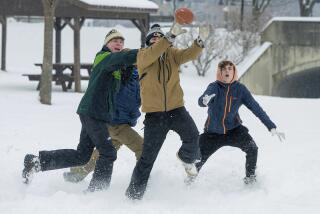Warm Snap a Cold Slap to Tourism
- Share via
CHICAGO — There is no more reliable measure of life in the upper Midwest than its frigid, six-month reign of winter. Lakes crust over with ice, the land disappears beneath deep snowpacks, and sparsely populated resort communities in Minnesota, Wisconsin, Michigan and Illinois swarm with ice fishermen and snowmobilers.
But this winter has been a strange exception. Temperatures have fluctuated between typical subzero reaches and balmy, spring-like climes, sowing confusion and creeping financial disaster in remote lakeside towns that depend on snow season tourism.
Even as the Great Lakes region had its first steady blast of stinging cold weather and snow last week, some major northern lakes in Minnesota and Wisconsin still were not iced over completely. And in many northern communities that gird for heavy snowmobile and cross-country use, tens of thousands of miles of trails had either no snow or were barely whited out with thin piles not packed deep enough to support recreational traffic.
In lakeside lodges where rooms are sitting empty and bait shops where business is slack, nervous merchants blame a familiar culprit--El Nino. They are partly right, say climatologists, who add that the tropical Pacific Ocean surface warming trend is one of several factors that have caused havoc this winter--along with climate shifts in the region and a tendency in recent decades for North Woods lakes to ice up later and later each winter.
“Everybody figures it’s El Nino,” said a disconsolate Jeff Kellog, owner of the Americ Inn and Jimmy’s Family Restaurant in Walker, a lakeside town in northern Minnesota. “Otherwise, we’d be doing gangbusters by now.”
Instead, business at the motel is down 60%, the restaurant is half-empty at times and Jeff and his brother, Dave, estimate they have been losing $5,000 to $6,000 a month. Kellog could see the problem right outside his window--pathetic patches of snow on bare ground. Without deep snow, snowmobilers have stayed home.
Across Minnesota, most smaller lakes have iced up. But there are still vast stretches of open water on larger lakes, even close to the Canadian border. Ice fishermen are setting up shacks by the thousands, but their numbers have been winnowed. And in many areas, they are being forced to cluster together because thin ice lies in treacherous expanses.
By this time of year, Mille Lacs Lake, a major fishing area in central Minnesota, usually is iced deeply enough to support 4,000 to 5,000 fishermen and their shacks, trucks and snowmobiles. When state game agents flew over the area last week, they counted only 1,500 shacks, jammed together in the only stretch not closed off by thin ice.
“It’s dangerous out there,” said Kim Elverum, water safety coordinator for Minnesota’s Department of Natural Resources. “We’ve had more ice rescues than we usually do.” There have been 10 snowmobile fatalities since November in the state. Four of the victims plunged into thin ice--a rarity for this time of year, Elverum said.
In Madison, Wis., where the Yahara lake chain is usually a sleek bed of ice by this time of year, ice fishing enthusiast Jim Kasuda was faced with the prospect of running a competition for children without a frozen lake to hold it on.
“There’s open water as far as you can see on Lake Monona,” Kasuda sighed, vowing he would hand out more than 200 ice fishing rods to kids even if they were unable to use them. “My buddies are all tensed out. They want to be out there on the ice. We should’ve been there over the week between Christmas and New Year’s. It’s driving everybody nuts.”
Still, the region’s long, drawn-out winters almost guarantee that the lakes eventually will ice over and snow beds will grow. But if El Nino and this winter’s confluence of other warming trends holds sway, it will allow only for a brief month or two of winter activity, said John Magnuson, a climatologist who directs the University of Wisconsin’s center for limnology, the study of fresh waters.
Magnuson says the balmy air currents of El Nino are an obvious factor in the upper Midwest’s atypical warmth, but not its only source. Another reason, he said, is the “oscillations” in 50-year weather patterns that happen to favor warming trends this winter. And there has been a trend in recent decades for North Woods lakes to freeze over later in the winter than they have in the past.
Aided by well-kept records from many communities, climate specialists know, for example, that Wisconsin’s Lake Mendota has tended to ice over eight or nine days later in the last half-century than it did in the previous 50 years.
“People up here may not realize it, but they’ve slowly been losing part of their winter,” Magnuson said. “It takes an aberration like this winter to show how much has changed over the years.”
More to Read
Sign up for The Wild
We’ll help you find the best places to hike, bike and run, as well as the perfect silent spots for meditation and yoga.
You may occasionally receive promotional content from the Los Angeles Times.






